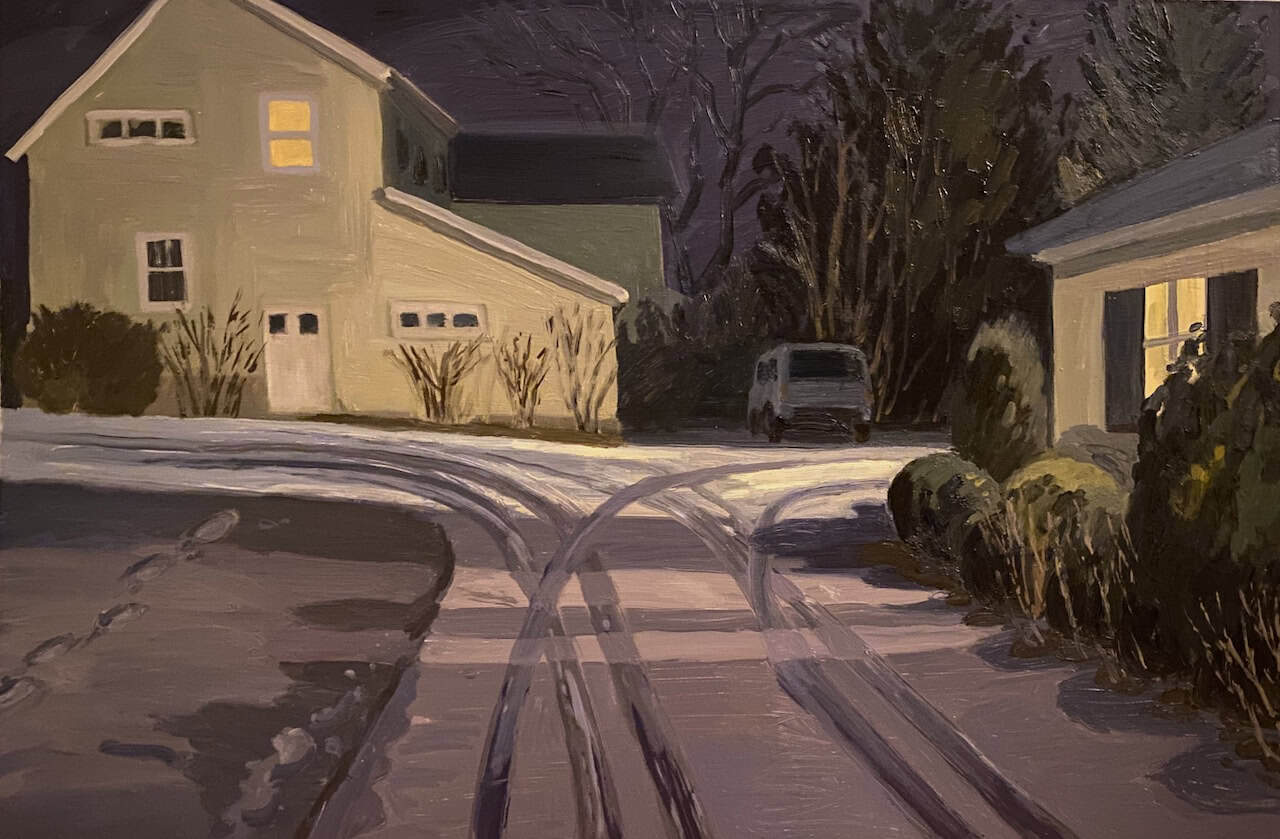Featured Artist
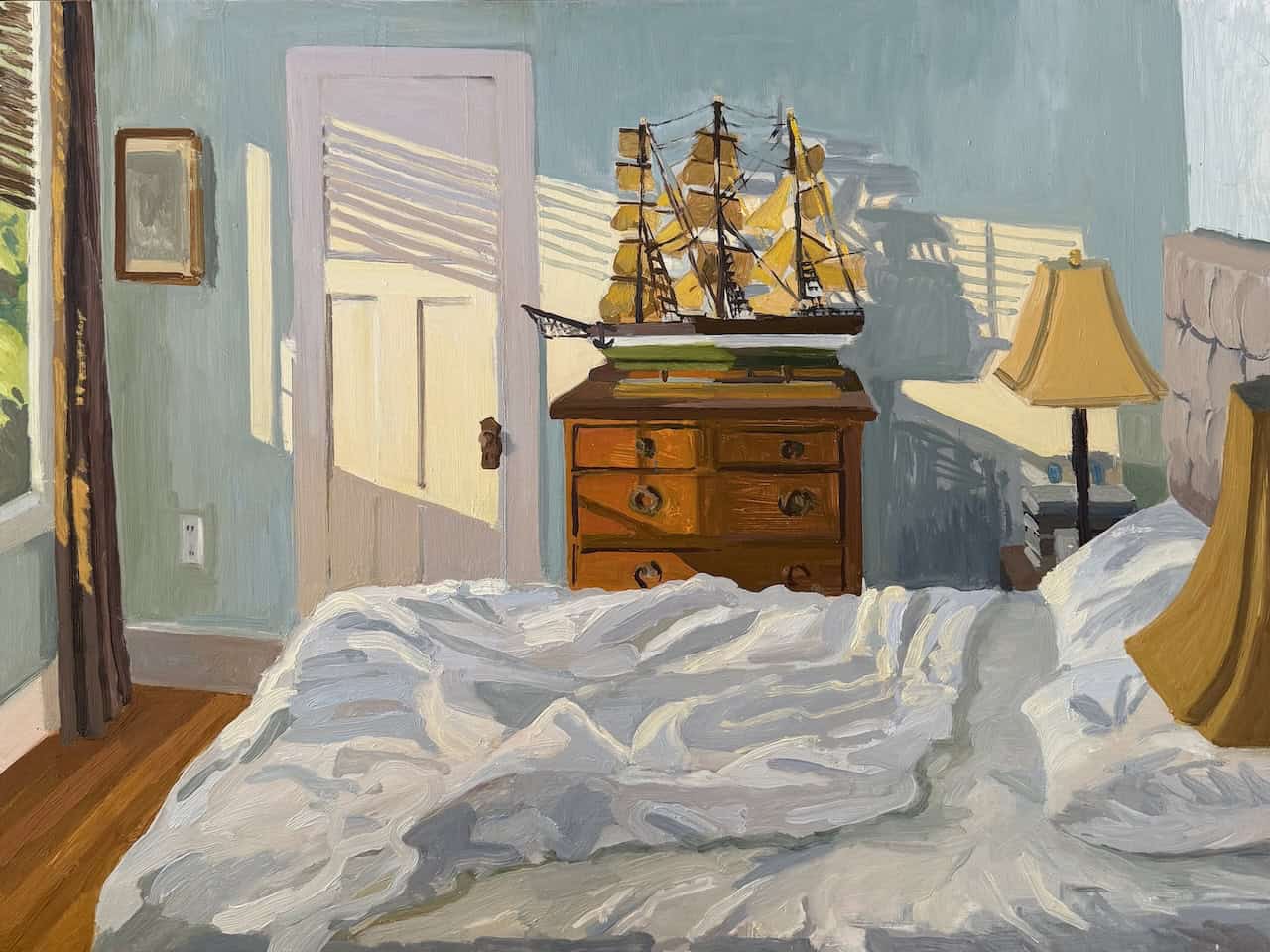
Peering Beyond the Frame — Colleen McGuire
When I visited Colleen McGuire in her Sharon, CT, studio, our conversation turned to the practice of plein-air painting and how it informs her broader artistic vision. McGuire’s work carries the sensibility of film stills – fragments of a larger story frozen in time. Each painting suggests that something has just happened, or is about to happen, just beyond the frame.
Her imagery invites a sense of cinematic suspense. Doors are left ajar. Curtains half conceal what lies behind them. A viewer feels as though someone has just stepped out of the scene – or is about to enter. This deliberate openness keeps the work alive, urging us to ask questions: What’s in the cupboard? Who’s behind the curtain? What lies beyond that doorway?
McGuire offers not only a view, but also the thrill of the unseen. By withholding just enough, she creates a tension that stirs curiosity and wonder. The result is a body of work that doesn’t merely depict a scene but conjures the lingering atmosphere of a story in motion.
What pulled you to this area?
Originally, I am from Windsor, Ontario, Canada. My husband and I were living in Long Island, where he was completing a medical residency. There was a job opening at Sharon Hospital, so we moved up here. That was 27 years ago. I hadn’t really envisioned myself living in a rural setting because I was more of a city person, but I’ve developed an appreciation for the peacefulness of Sharon. Had we lived in the city, we’d be in a much smaller living space than we are now.
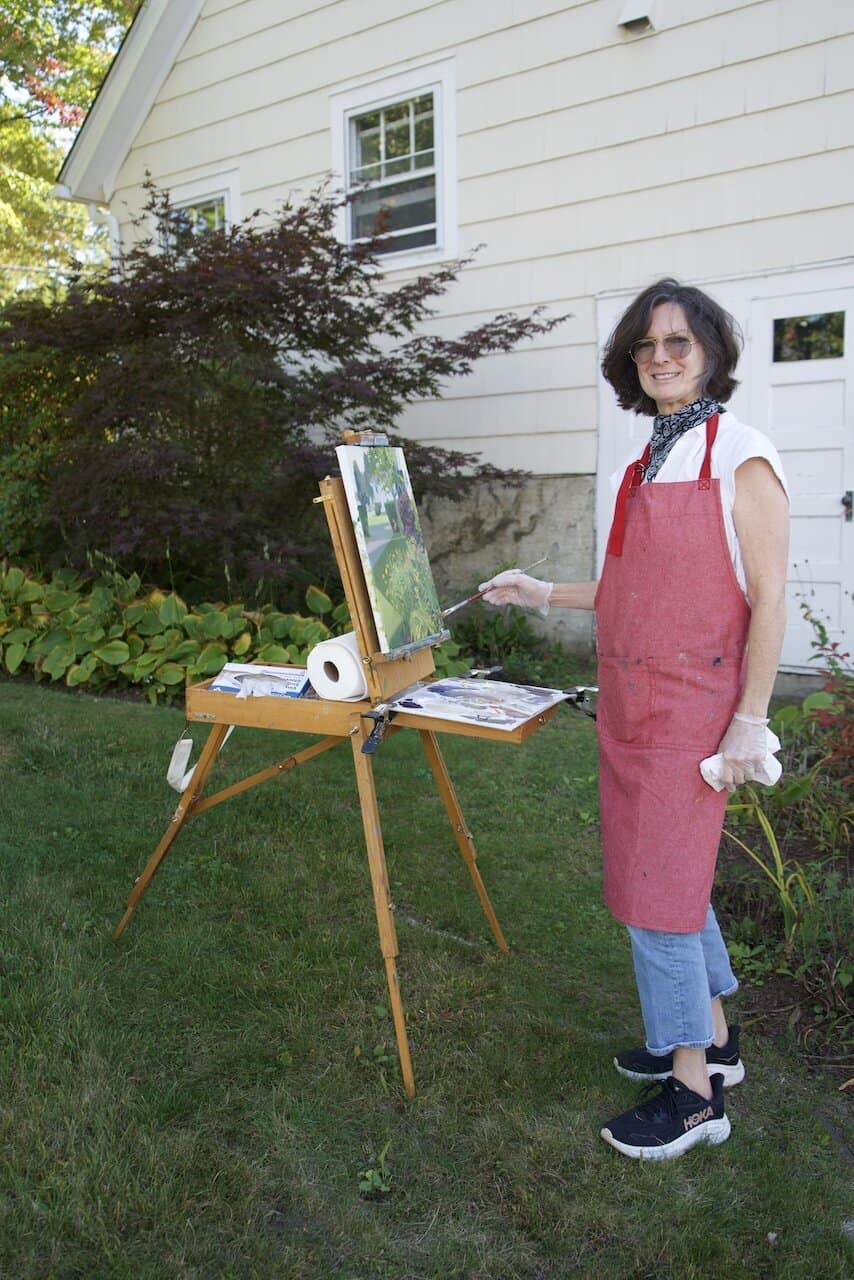
Have you always painted?
I always loved to draw and paint. My mom was a writer, but also a Sunday painter. I dabbled with her paints, so art was essential to me. Yet she would never have suggested heading to art school, even though it was evident that I loved art. Initially, I majored in sociology in college, but I dropped out after my first year. After a period of living in Toronto for four years and running a vintage clothing store, I moved to Westchester, NY, where I started attending art school at SUNY Purchase. I knew immediately that art was my vocation, and I haven’t looked back.
So, what does art mean to you?
That’s a loaded question. My life revolves around painting, drawing, and looking at art. For me, it’s about observing the world around me and capturing it in painterly terms. As an educator, I often think in formal terms, such as composition, color, and value. It’s a balance between painting intuitively and thinking critically. I love to paint the outside world, but lately I’ve been painting the interior spaces of my house, as a way to document my surroundings, but also to explore the idea of interiority. In psychology, the house can be seen as representing the self, and I see my interior spaces as a reflection of who I am.
I’ve always been drawn to the work of Edward Hopper and Edouard Vuillard, who were both painters of interiors.
This reminds me of Gaston Bachelard’s The Poetics of Space, which was one of my favorite books.
It’s so dense, it is a pick-up, put-down book. In my own work, I also think about the structure of poetry, or creative writing, and also perhaps filmmaking. I think about how I can create a painting that resonates with me, but also with the viewer. I like this idea of capturing a moment in time before it’s gone and capturing a sense of place. I think about the way that a director might set the stage.
My paintings are not all staged, but when I work on a still life or an interior, especially, it’s different from a landscape. With the landscape, you have to deal with the elements. If it’s cold or dark, I’ll paint in my car, sometimes with a flashlight illuminating my painting. My husband calls it the paint mobile, a studio on wheels.
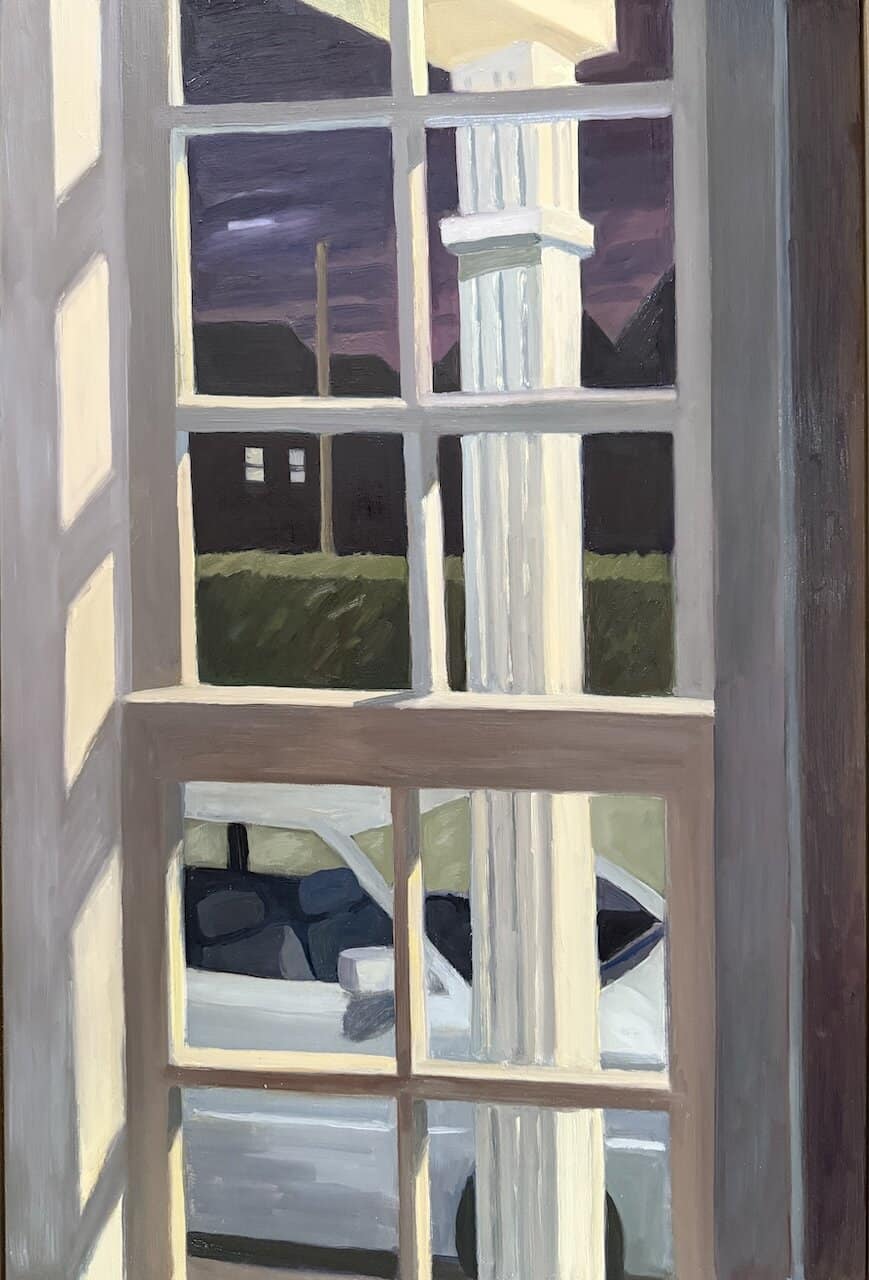 Observation is key. I once relied on photographs but abandoned them to preserve the immediacy of the painting experience. Being in that moment is really important to me. It’s about capturing the subtleties of light.
Observation is key. I once relied on photographs but abandoned them to preserve the immediacy of the painting experience. Being in that moment is really important to me. It’s about capturing the subtleties of light.
Color and light are my constant challenges and companions. For example, I liked the structure of a painting that I made two years ago; however, the color was driving me crazy. Only yesterday was I able to finally resolve it. A painting might take a day to complete or a year.
I want my paintings to appear spontaneous, but the process is not necessarily always that way. The night scenes demand a pared-down palette, while daylight requires expansiveness – careful balancing of warm and cool tones to evoke not just form, but atmosphere. It is this pursuit of harmony between color, light, and sensation that animates the work and keeps me searching for the moment when everything finally coheres. I often work on panels, savoring the luminous quality that comes when thin layers of paint allow the white ground to shine through. I am pretty economical with paint; however, these bedroom paintings are an exception: layered and dense but attempting a vibrancy that resists heaviness.
What motivates your practice?
Painting begins with a fleeting moment – a shadow cast on a wall, the way steam fogs a mirror, or the light shifting across a room I have known for decades. Having lived in the same house for 27 years, I have grown deeply attuned to its rhythms, witnessing how light changes daily and seasonally. I’ll see a shadow on a wall and want to capture the sensation of light as well as the geometry of the shapes. I love how everything changes.
What motivates me is this interplay of light, space, and the sheer act of painting. Sometimes it emerges in unexpected ways: stepping from the shower into a steamy room, smearing the mirror, and finding delight in the playful abstraction created. Though I do not consider myself an abstract painter, moments like these allow a nod toward abstract expressionism while staying rooted in observation.
Our rambling old house is a studio in itself. The messy intimacy of a closet becomes a study in atmosphere and perspective. The bathroom, with its luminous light, has inspired multiple paintings. Even my beloved curtains, once destined to be discarded, found new life on the canvas when I realized I had to paint them before I got rid of them. The excitement lies in mark-making: the immediacy, the energy, the way a gesture can capture the spirit of a moment.
Through these intimate acts of attention, the domestic spaces become portals of memory and painterly discovery. Which painters or writers do you follow?
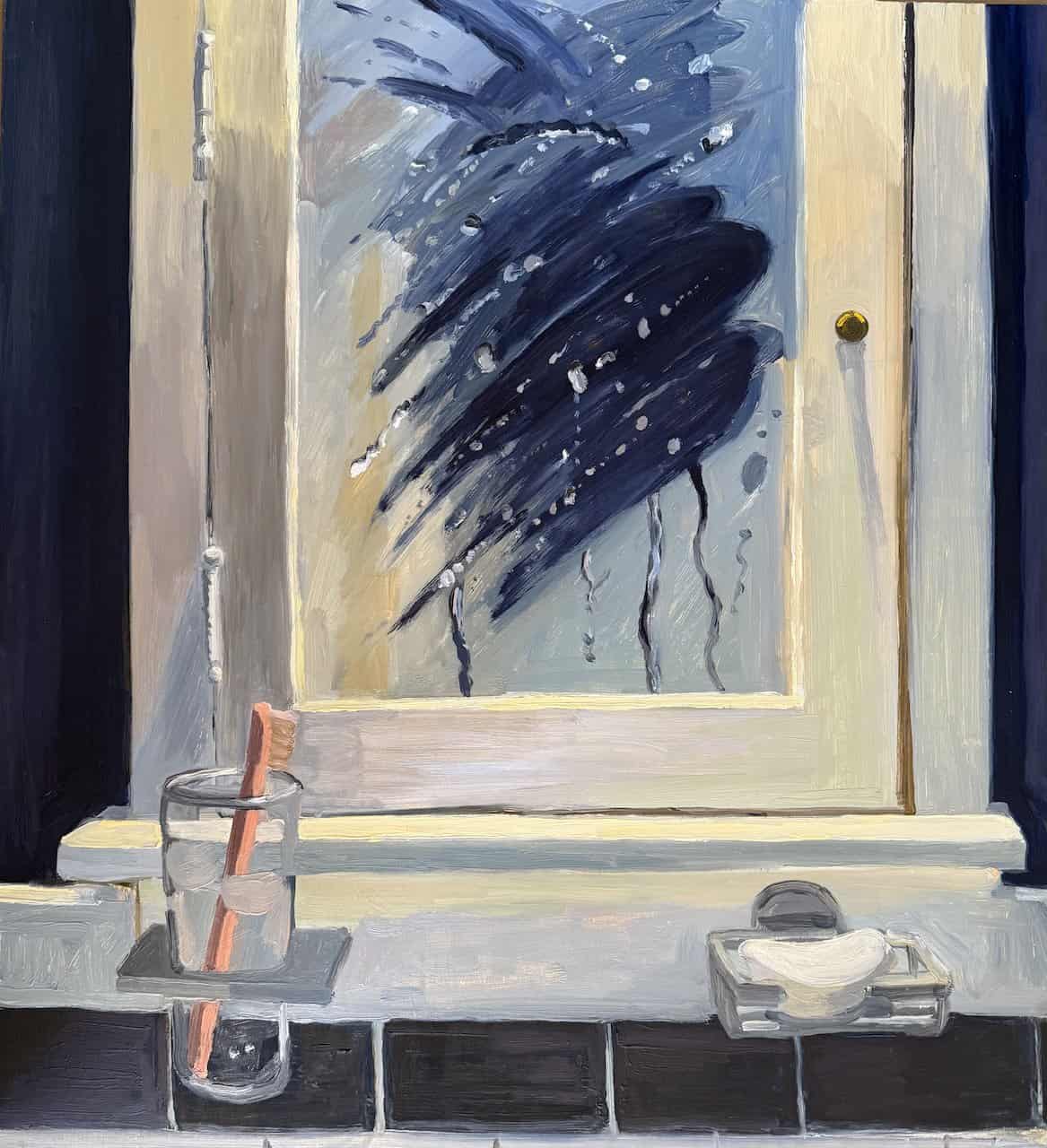
I love Henri Matisse, Pierre Bonnard, Édouard Vuillard, and Fairfield Porter, who balance intimacy, freshness, and light. Their work resonates with sensitivity to color and atmosphere. I draw inspiration from Lois Dodd for the way she distills a moment into visual poetry. I also love Scottish painter Richard Walker for the immediacy of his brushwork, and his experimentation with lighting. I grew up loving comics, so painters like Philip Guston and Richard Bosman appeal to me for their sense of playfulness.
Sometimes I ask myself, why am I doing this? Yet the answer is always the same: the drive to create is something within me, an impulse that cannot be ignored. I graduated from art school at the age of thirty, then earned my master’s degree two decades later, from Western Connecticut State University, which was an excellent education, it deepened my practice and perspective.
Like many artists, I experience the tension between solitude and community. I tend to stay in my own little bubble; however, I try to get out to attend more openings and visit galleries. Living close to New York is essential because I spend a lot of time visiting the galleries and museums there.
As an artist, I tend to be more introverted. That balance between the private world of painting and the public world of exhibition remains an ongoing negotiation as an artist.
If you could beg, borrow, or steal a piece of work anywhere in the world, what would it be?
Oh, so many options to work with. I really like Deborah Zlotsy’s work. I would love a Richard Walker, the Scottish painter I mentioned, but I would really love to live with a Bonnard interior if that was possible!
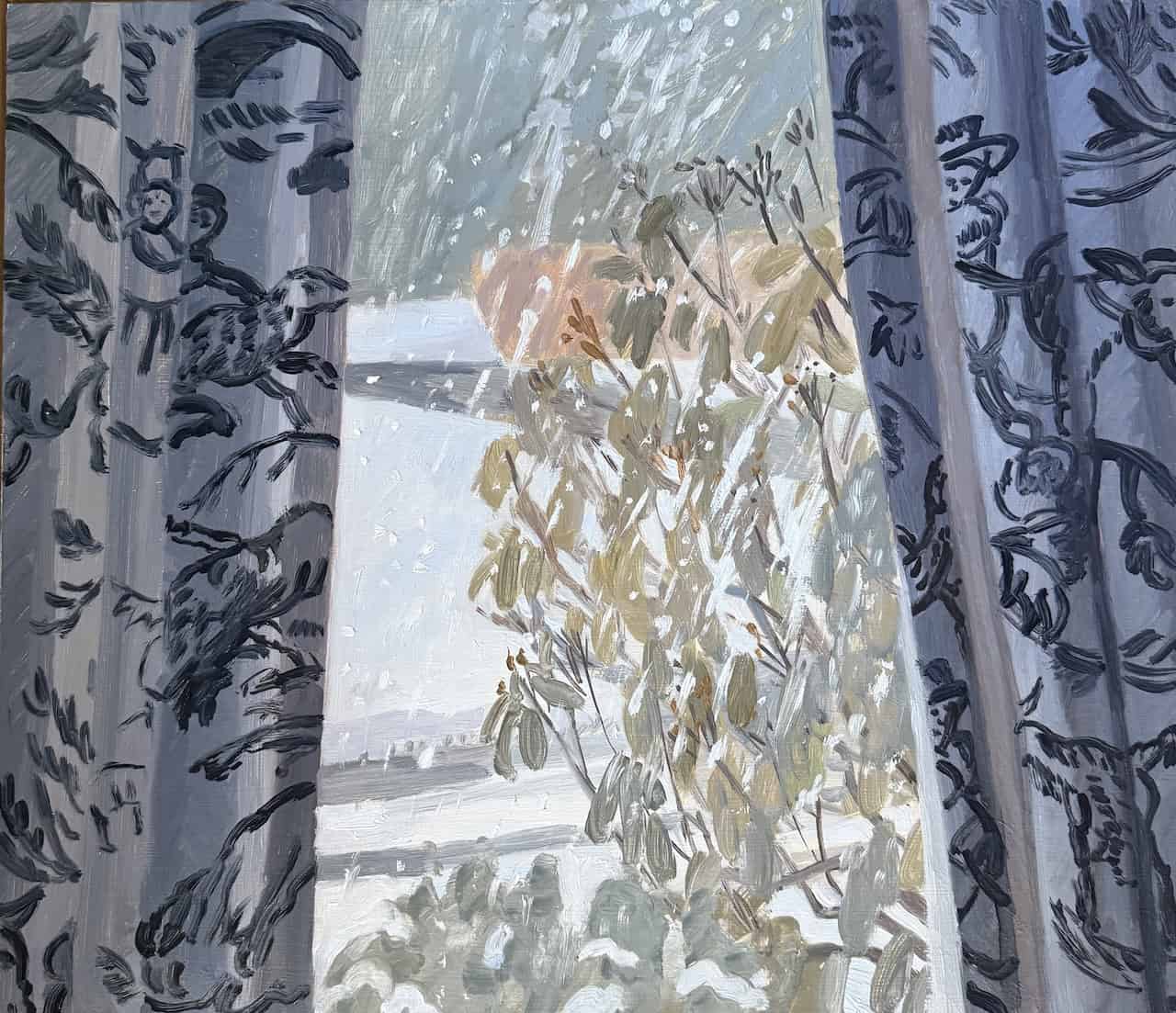 Do you have a favorite time of day for working and navigating your practice whilst teaching?
Do you have a favorite time of day for working and navigating your practice whilst teaching?
When I’m not teaching, I work in the morning, and at night too. I paint, draw, or read, trying to make it a daily practice. Sometimes I stay awake at night so I can paint. It’s great now that the days are getting shorter, because I can paint at 7pm, which isn’t so late.
When I completed my master’s degree at Western Connecticut State University in Danbury, they offered me a position teaching foundational art courses, so I travel there twice a week. I also taught art at Hotchkiss for five years which I loved, but I retired so that I could have more time to paint. For me teaching and painting are intertwined: each sustains the other, enriching my practice.
What was the best advice you were given regarding your practice that you can share?
I think the essence of painting lies not in innate talent but in persistence. The late artist Paula Rego said: “Every idea should include four paintings – the first two are practice, the third is when you find your rhythm, and the fourth may already push too far.” I have taken this to heart. One of the best things I’ve learned is to keep going and not be discouraged by your first painting, she says. “Your first painting could be a warm-up. If something fails, don’t give up. Keep going.”
Likewise, Jasper Johns’s mantra: “Do something, then do it again.” Repetition builds not only skill but also insight. It’s perseverance over everything. I am passionate about sweat equity, and I often share a quote by Thomas Edison with my students, “Genius is one percent inspiration and ninety-nine percent perspiration.”
Humility is also part of being an artist. Even when I am not painting or drawing, I am immersed in art – reading or visiting exhibitions. It is my whole life. Finally, I learned that paintings have their own internal logic and that the subject matter is the entry point into a painting, but the way the artist arranges the space, the colors they choose, and the way they apply the paint all contribute to the meaning of the painting.
Do you have a project or series you’re most proud of?
I really enjoy the interiors; that is where my heart is currently. An interior feels more personal and more like a stage. I’ve always loved architecture and the idea that when you paint a space, the viewer can sense if they could occupy that space. I’m also getting back into larger paintings. When you view a larger work, sometimes it feels more like you could step into that painted space.
McGuire’s work pulls daily life to the forefront, allowing us to rejoice in the simplicity of both place and home. Her harmonious palettes capture light from both internal and external views and pause the moment. She often repeats a scene. Each image is slightly different, but viewing them together brings multiple subtleties to the variations. •
McGuire’s work has been shown at Pamela Salisbury Gallery in Hudson, NY; Standard Space in Sharon, CT; and Western CT State University as well as with Armature Projects, the Hillstead Museum in Farmington, CT, and Blue Mountain Gallery in New York. Her upcoming show, Wish You Were Here at Tremaine Gallery at Hotchkiss School, will be presented alongside work from Kinderhook-based artist Fern Apfel. Show dates: November 4-January 25. Opening reception: November 15, 4-6pm. Artist talk: November 13, 7-7:45pm at The Hotchkiss School.
For further information on McGuire’s work, please visit her website: cmcguireart.com or Instagram: @colleenmcguire_art
